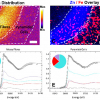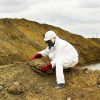Ian Croudace and Guy Rothwell
National Oceanography Centre, Southampton, S014 3ZH, UK. E-mail: [email protected]
Introduction
Non-destructive, high resolution, sediment core scanners incorporating X-ray fluorescence (XRF) spectrometry are now widely used by sub-disciplines in the earth and environmental sciences and have revolutionised the analysis of sediment cores. These powerful instruments allow the cores to be analysed rapidly with virtually no sample preparation. They can record along-core variations for many elements in the Periodic Table from Al to U and detection limits down to a few ppm can be achieved in favourable conditions depending on the acquisition dwell time.
Sediment cores from diverse marine and lake environments are investigated because they often retain excellent records relating to past processes such as climate change, extreme events (e.g., floods, storms, landslides, earthquakes, volcanoes, tsunamis etc.) and pollutant inputs. Temporal information can also be obtained from elemental profiles in some cases by identifying high-resolution impulse events of known age (e.g., volcanic ash layers, storm surges, earthquakes). Other elemental variations can provide insights into climate change oscillations, sediment provenance and marine circulations.
In the 1990s, the expanding interest in past climate change and the growing collections of scientific cores held in repositories demanded that fast multi-sensor scanners be developed to extract high-resolution profiles from sediment cores. Instruments offering resolutions of 1 cm were available at that time and researchers could only realistically decipher cores down to centennial and decadal timescales. It became clear that resolutions of at least 0.1 mm were required to investigate the variations found in laminated lake and marine sediments which would then make it possible to identify events with an annual timescale (for example, References 1 and 2). Since they were developed, these instruments have become invaluable and super-efficient tools for the geoscientist and they allow non-destructive core investigations to proceed at unprecedented rates and resolutions.
The origin of one of the leading core scanners, the Itrax, began in 2001 when the authors of this article, based at the Southampton Oceanography Centre, SOC (now the National Oceanography Centre), conceived the need for a new-style sediment core scanner.2 They envisaged an integrated non-destructive instrument that would provide high-resolution elemental analysis along with optical and X-radiographic imaging. Although two other core scanners existed at the time neither system offered such a critical combination. The most notable of these early core scanners was the CORTEX developed at the Netherlands Institute for Sea Research in the late 1990s,1 which evolved and became commercialised as the Avaatech Core scanner (www.avaatech.com).
The SOC concept scanner required a collaborative venture with a specialist XRF instrument designer and in 2002 an arrangement was made with Swedish company Cox Analytical Systems (www.coxsys.se). Cox Analytical Systems based in Gothenburg were considered critical partners in the venture as they had formerly produced a successful XRF microscope, albeit directed mostly at the forensics market. The SOC–Cox collaboration proved highly fruitful and in April 2003 the prototype Itrax instrument was delivered to the Southampton Oceanography Centre. It provided contactless investigation of cores and included innovations such as a high flux X-ray source, X-ray capillary waveguide, a positionable silicon drift detector (SDD), optical and radiographic cameras, and an ultra-high precision sample drive platform. The instrument was launched to the scientific community at a conference held in Southampton in 2003 entitled New Techniques in Sediment Core Analysis that was published as a book in 2006.3 The two other key manufacturers also demonstrated their instruments and capabilities at the meeting. At the current time the Itrax and the Avaatech instruments are the leading X-ray core scanners and are installed in approximately equal numbers in leading international scientific institutions throughout the USA, Europe and Asia.
Collection of cores
Sediment cores are collected, often at considerable cost, from difficult locations (oceans, enclosed seas, large lakes). A range of devices are used to extract these cores such as gravity corers, hydraulic piston corers through to giant piston corers. Given the cost and logistical difficulty of collecting long cores, international research groups collaborate to maximise the scientific value and to ensure the tight management of the core material. Cores are often split longitudinally into 1-metre lengths or sub-sampled into U-channels before being moisture-sealed and stored in cold conditions in national core repositories (e.g., www.boscorf.org). Initial non-destructive investigation is a crucial stage before any further destructive sampling is carried out. Such direct sub-sampling is essential to obtain accurate data on a range of crucial parameters such as palaeotemperature and sediment age.
Palaeolimnologists have collected many hundreds of metres of lake sediment cores and have become significant users of high-resolution XRF core scanners. Lake sediments are often organised as fine-scale, seasonal layers that contain valuable proxy records of past climate, see Table 1. The significant increase in drilling of large lakes, from the equator to the poles, with their exceptional long-term records (as identified by International Continental Scientific Drilling Programme, www.icdp-online.org) means that X-ray core scanners are in big demand.
Table 1. An illustration of why sediment cores are important. Selection of lakes holding exceptional climate records (XRF core scanners are playing a crucial role in investigating the core material). Ma: 106 years; ka: 103 years.
Lake Baikal has never been glaciated in its 20–25 million year history and ongoing palaeoclimate research there is important because it offers unparalleled opportunities to recover a relatively high latitude record from an intra-continental setting that is isolated from marine influences. The sedimentary record in Lake Baikal is extremely long and continuous with sedimentation rates varying from 1 cm/ky to 1 m/ky. The Baikal record therefore offers exciting opportunities to study palaeoclimate change on a variety of temporal scales and resolutions. (Quote from Baikal Drilling Project, www.icdp-online.org.)
| Lake | Location | Sediment thickness (core length recovered) | Age | Origin |
| Lake Malawi | Malawi | (623 m in seven holes) | >7 Ma | Tectonic (East African Rift) |
| Lake Bosumtwi | Ghana | 1.8 km | ~1 Ma | Impact crater |
| Lake Baikal | Southern Siberia | 5–8 km in some places (>100 m) | 20–25 Ma | Tectonic (rift-related) |
| Lake Suigetsu | Japan | (73.5 m) | ~150 ka |
|
| Lake El'gygytgyn | Siberian Arctic | (>300 m) | 3.6 Ma | Impact crater from a 1 km asteroid |
| Lake Ohrid | Albania/Macedonia | (>700 m) | 3–5 Ma | Tectonic |
| Lake Tana | Ethiopian highlands | (>92 m) | >15 ka | Tectonic |
Practical aspects of analysing sediment cores
In practice, sediment cores, when collected, can vary up to 12 cm diameter and from several centimetres to several hundred metres in length. Long cores are normally cut to 1 m or 1.5 m lengths before being stored in cold conditions to prevent drying out until they are investigated. Traditionally, in the 1980–1990s the analysis of sediment cores was made through multiple investigations involving a combination of medium resolution scanners (multi-sensor core loggers, MSCL) and destructive sub-sampling at centimetre scale. The MSCLs do not provide elemental data and such information, when required, was often obtained by analysing sub-samples with wavelength-dispersive XRF (WD-XRF) spectroscopy or inductively coupled plasma-optical emission spectrometry (ICP-OES). Though accurate and sensitive, such analytical procedures were slow and could take approximately two weeks of laborious effort to process and analyse a metre of core.

The Itrax (see Figure 1) represents a highly successful exemplar of a modern XRF core scanner and is able to carry out a 200 µm resolution scan of a 1 m core for major elements in about six hours; with 5000 X-ray spectra being collected. The analytical dwell-time used is selected by the operator according to the element precision required. If trace element data are required then the analysis time would be extended by a factor of three to six. The Itrax also acquires optical and radiographic images that have immense value and provide additional insights that aid in interpreting the core data. The high-resolution radiographic image, with a maximum individual pixel resolution of ~20 µm, can reveal individual sedimentary layers (lamellae), grains, gas bubbles etc. and assist in the interpretation of the elemental profiles. The radiographs also allow counting of varves (seasonal couplets) that then allow variations in annual sediment accumulation rate to be determined.
Samples are normally measured as longitudinally split cores covered with 2 µm XRF film to inhibit drying out during measurement. Cores as long as 1.8 m can be analysed and, if trace element data are being acquired, the total analysis times may be as long as 24–48 hours. The beam size of the X-ray capillary waveguides fitted to the Itrax can be either 100 µm × 2 cm (ideal for finely laminated lake sediments) or 200 µm × 2 cm (for general applications). This rectangular X-ray beam both excites the sample for XRF and also passes through the sample to the radiographic camera. The radiographic "slices" are re-assembled to generate a 16-bit digital radiographic image; there is a maximum 20 µm pixel resolution.
Conventional XRF vs Itrax
Modern X-ray fluorescence analysis systems [WD-XRF and energy dispersive XRF (ED-XRF)] are well-established as offering fast, non-destructive and clean forms of analysis that can routinely deliver elemental concentration data of high accuracy and reproducibility. In conventional XRF systems incorporating a vacuum, elements from Na to U can be readily measured in solids and liquids with a precision better than ±0.5% in many cases. Limits of detection can be as low as 0.1 ppm for some elements but are more typically in the low ppm range for environmental/geological materials. Virtually any sample type can be run (pressed powders, glasses, ceramics, metals, rock, coal, plastic, oil etc.). Conventional laboratory systems are designed for small samples that can be prepared under ideal conditions. Sediments contained in cores are certainly not ideal as they are frequently long, wet and commonly organised in layers of varying thickness and grain size. Core scanners are specifically designed to be able to deal with the challenges of non-destructively analysing sediments in their relatively unprepared and almost natural state. It is also possible to exploit the rapid analysis capability of core scanners by "containerising" them for deployment on sea-going vessels.
The Itrax was designed with several innovations to efficiently examine sediment cores from all environments (see Table 2), including water-cooled 3 kW X-ray tubes (Mo and Cr anode options) coupled to a flat-beam, X-ray capillary wave-guide, SDD detector to ensure good energy resolution at high count-rates, 20 μm resolution digital X-ray radiographic camera (16-bit range), see, for example, Figure 2 and a ultra-high precision motorised sample transport system.
Table 2. Comparison between the Itrax core scanner and a conventional WD-XRF.
| Itrax core scanner | Conventional WD-XRF | |
| Typical X-ray tube used | 3 kW Cr or Mo | 4 kW Rh |
| X-ray detection system | Silicon drift detector | Gas flow, scintillation, sealed Xe |
| Practicable XRF scanning resolution | ≥100 μm | Bulk analysis |
| X-radiographic spatial resolution (selectable) Dimension of radiographic slice | ≥20 μm 100 μm × 2 cm or 200 μm × 2 cm | Not possible |
| Analysis area (using a 4 mm diameter entrance window for the SDD) | 0.004 cm2 (with a 100 μm capillary) 0.008 cm2 (with a 200 μm capillary) | ~10 cm2 (a bulk analysis technique) |
| High resolution optical image | RGB digital camera | Not available |
| Time to obtain a radiographic image for a 1 m core at 200 μm resolution | ~0.5 h | Not possible |
| System software for X-ray spectral and data analysis | Available | Available |
| Sample treatment and preparation requirement | Non-destructive analysis requiring a flat exposed surface covered by 2 µm polypropylene film to inhibit drying | Requires physical sampling of the core. Sampling is limited to about 5 mm resolution |
| Sample analysis medium | Air | Vacuum or He |
| Time to acquire data for a 1 m core at 200 μm resolution for selected major and minor elements (K, Ca, Fe, Sr) | ~2 h | 10 working days in total (includes sample preparation and running 100 samples at 1 cm resolution) |
| Time to acquire data for a 1 m core at 200 μm resolution (e.g. Al. Si, S, Cl, K, Ca, Fe, As, Pb, Zn, Br, Rb, Sr, Zr) for selected major and trace elements | ~48 h | 10 working days in total (includes sample preparation and running 100 samples at 1 cm resolution) |
| Nominal detection limits (100 s); see Table 3 Dependent on tube anode, excitation conditions, count-time, atomic number and sample composition | ~100 ppm for Ti ~10 ppm for Sr | 10 ppm for Ti 0.5 ppm for Sr |

Application areas and case studies
Some typical application areas are summarised in Table 3 and Figures 3–5.
Table 3. Examples of some application areas.
| Study of cyclic chemical (and mineralogical) changes in marine and lake sediment to infer climate change |
| Study of laminated lake sediments from arctic and alpine lakes to provide climate variability data over decadal to centennial timescales |
| Counting of varves and chemical cycles in lake sediment to infer variations in sediment accumulation rate and environmental change |
| Identification of volcanic ash horizons in lake sediment to date layers (using elemental variations and radiographic images) |
| Identification of elemental spikes and other compositional changes to indicate abrupt/extreme events such as floods, storms, earthquakes, landslides etc. |
| Studies of redox-driven, elemental redistribution processes |
| Determination of sedimentary and tectonic processes in marine basins |
| Identification of records of heavy metal pollution in coastal, estuarine and lake sediment |
| Environmental forensics |
Case study I—Mediterranean sapropelic sediments as indicators of past climate change
The Mediterranean Sea has been a critical study area for oceanographers because it holds a sensitive record of past climate. Its small size and partial isolation from the global oceans means that past records of altering climate are magnified and can be used to understand global changes.
Changing climate cycles over the last 10,000 years and beyond are recorded in Mediterranean sediments and is known as a result of studying hundreds of metres of cored sediment collected at different locations by international marine expeditions. Evidence for these cyclical changes is recorded in the cores visually as dark, organic-rich sediment called sapropels that formed during periods of wetter climate. The sapropels represent the deposited remnants of phytoplankton blooms that grew in response to enhanced nutrients supplied by the increased run-off from the Nile. Typical deep-sea sediments contain little organic carbon and therefore the sapropel layers, containing elevated carbon, stand out clearly from their enclosing creamy coloured mud.

Sapropels are geochemically distinctive and contain enhanced concentrations of carbon and redox-sensitive elements such as S, Fe, As, Mo and V, see Figure 3. Other elements such as Ba, Cu, Ni, Pb and Zn are also enriched and core-scanner-derived elemental profiles provide several important insights into the direction of movement of elements during diagenesis, the oxidation of the sapropel and processes that lead to narrow zones of unusual element enrichments like Cu.
Case study II—coastal pollution/environmental forensics
Estuaries and coastal embayments are often sites with long legacies of industrialisation (e.g., the rivers Severn, Mersey and Humber in the UK, Bilbao and Augusta Bay, Sicily). Establishing records of pollution in such areas is necessary from various legal standpoints (national and international regulations) and ongoing work shows it is possible to identify individual polluters through careful multifaceted investigations that include using core scanners.

The Newport Deep (Severn Estuary) exemplifies an area having a 100+ years industrial history and submarine cores have been found to contain variable amounts (modest) of pollution from diverse sources such as coal extraction/processing, Pb–Zn smelters, steel plants, incinerators, paper mills, nuclear power stations etc. (see Figure 4). Rapid and non-destructive scanning of Newport Deep submarine sediment cores, along with other investigations, allows clear records to be established of changing pollutant inputs such as heavy metals.

Summary and future developments
For several decades oceanographers investigating marine cores have used a variety of low-medium resolution (centimetre-scale) scanning tools. These devices persist as general scanners for the oceanographic community but the "tool box" has been significantly augmented by the new generation, high-efficiency, high-resolution X-ray core scanners. Judging from the significant increase in publications, from 2003 onwards (Figure 6), it is clear that integrated, multi-sensor X-ray core scanners have revolutionised rapid, non-destructive, high-resolution analysis of sediment cores for all user communities. The rapidly acquired data they generate serve to guide more specific scientific studies. There is also a considerable and ever growing demand from the lake scientific community that require many hundreds of metres of cores to be scanned for radiographic and elemental profiles. With the need to increase performance and capability it is fortunate that the current instrument platforms lend themselves to enhancements through the addition of new sensors, by increasing sensitivity for the low z elements and by offering the potential of accelerating core analysis.

References
- J.H.F. Jansen, S.J. Van der Gaast, B. Koster and A.J. Vaars, "CORTEX, a shipboard XRF-scanner for element analyses in split sediment cores", Marine Geology 151, 143–153 (1998). https://doi.org/10.1016/S0025-3227(98)00074-7
- I.W. Croudace, A. Rindby and R.G. Rothwell, "Itrax: description and evaluation of a new multi-function X-ray core scanner", in New Techniques in Sediment Core Analysis, Ed by R.G. Rothwell. Geological Society, London, Special Publication 267, pp. 51–63 (2006). https://doi.org/10.1144/GSL.SP.2006.267.01.04
- R.G. Rothwell (Ed.), New Techniques in Sediment Core Analysis. Geological Society, London, Special Publication 267 (2006).














